Courses

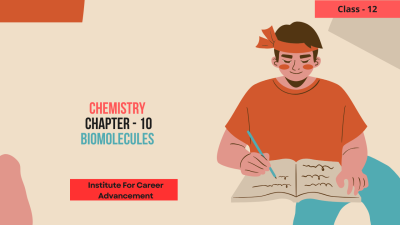
 Compare
Compare
In Class 12 Chemistry, you'll delve into the fascinating world of biomolecules – the essential building blocks of life! These complex organic compounds come together to form the structures and carry out the functions of all living organisms. Here's a quick glimpse: Carbohydrates: Imagine the energy source for your cells! Sugars, starches, and cellulose (plant cell walls) all fall under this category. Proteins: The workhorses of the cell, responsible for building tissues, enzymes that drive reactions, and even antibodies that fight disease. Lipids: Fats, oils, and waxy substances. They store energy, provide insulation, and form cell membranes. Nucleic Acids: The blueprint of life! DNA and RNA store and transmit hereditary information. Other Biomolecules: Vitamins, enzymes, and hormones also play crucial roles in various biological processes. দ্বাদশ শ্রেণিতে রসায়নে, আপনি জৈব অণুগুলির আকর্ষণীয় জগতে প্রবেশ করবেন-জীবনের প্রয়োজনীয় বিল্ডিং ব্লক! এই জটিল জৈব যৌগগুলি একত্রিত হয়ে কাঠামো গঠন করে এবং সমস্ত জীবের কার্য সম্পাদন করে। এখানে একটি দ্রুত ঝলকঃ কার্বোহাইড্রেটঃ আপনার কোষের শক্তির উৎস কল্পনা করুন! চিনি, শ্বেতসার এবং সেলুলোজ (উদ্ভিদ কোষ প্রাচীর) সবই এই বিভাগের অধীনে পড়ে। প্রোটিনঃ কোষের ওয়ার্কহর্স, টিস্যু তৈরির জন্য দায়ী, এনজাইম যা প্রতিক্রিয়া চালায় এবং এমনকি অ্যান্টিবডি যা রোগের বিরুদ্ধে লড়াই করে। লিপিডঃ চর্বি, তেল এবং মোমের পদার্থ। তারা শক্তি সঞ্চয় করে, নিরোধক সরবরাহ করে এবং কোষের ঝিল্লি গঠন করে। নিউক্লিক অ্যাসিডঃ জীবনের নকশা! ডিএনএ এবং আরএনএ বংশগত তথ্য সঞ্চয় করে এবং প্রেরণ করে। অন্যান্য জৈব অণুঃ ভিটামিন, এনজাইম এবং হরমোনও বিভিন্ন জৈবিক প্রক্রিয়াতে গুরুত্বপূর্ণ ভূমিকা পালন করে।
0 Lessons
Hours

 Compare
Compare
In Class 12 Chemistry, you'll encounter amines, fascinating organic compounds derived from ammonia (NH₃). Imagine replacing one or more hydrogen atoms in ammonia with hydrocarbon groups (like the ones in gasoline or cooking oil), and you've got an amine! These newfound groups can be alkyl (straight or branched chains) or aryl (attached to a benzene ring). Amines come with some interesting properties: Ammonia-like odor: Simpler amines often have a fishy smell, similar to ammonia. As the hydrocarbon chain gets longer, the odor weakens. Solubility: Lower molecular weight amines can dissolve in water due to hydrogen bonding with water molecules. Basic nature: Amines can act as bases by accepting protons (H⁺) due to the presence of the lone pair of electrons on the nitrogen atom. দ্বাদশ শ্রেণীর রসায়নে, আপনি অ্যামোনিয়া (এনএইচ 3) থেকে প্রাপ্ত আকর্ষণীয় জৈব যৌগ অ্যামাইনের মুখোমুখি হবেন। কল্পনা করুন যে অ্যামোনিয়ায় এক বা একাধিক হাইড্রোজেন পরমাণুকে হাইড্রোকার্বন গ্রুপে (যেমন পেট্রোল বা রান্নার তেলে) প্রতিস্থাপন করলে আপনি একটি অ্যামাইন পাবেন! এই নতুন গ্রুপগুলি অ্যালকাইল (সোজা বা শাখাযুক্ত চেইন) বা অ্যারিল হতে পারে। (attached to a benzene ring). অ্যামাইনের কিছু আকর্ষণীয় বৈশিষ্ট্য রয়েছেঃ অ্যামোনিয়ার মতো গন্ধঃ সরল অ্যামাইনের প্রায়শই অ্যামোনিয়ার মতো একটি মাছের গন্ধ থাকে। হাইড্রোকার্বন শৃঙ্খল দীর্ঘ হওয়ার সাথে সাথে গন্ধ দুর্বল হয়ে পড়ে। দ্রবণীয়তাঃ জলের অণুর সঙ্গে হাইড্রোজেনের বন্ধনের কারণে কম আণবিক ওজনের অ্যামাইন জলে দ্রবীভূত হতে পারে। মৌলিক প্রকৃতিঃ নাইট্রোজেন পরমাণুতে একক জোড়া ইলেকট্রনের উপস্থিতির কারণে অ্যামাইনগুলি প্রোটন (H +) গ্রহণ করে ক্ষার হিসাবে কাজ করতে পারে।
0 Lessons
Hours
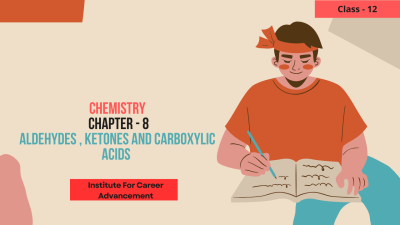
 Compare
Compare
In Class 12 Chemistry, you'll encounter a fascinating trio of organic compounds with a special "carbonyl group" (C=O): aldehydes, ketones, and carboxylic acids. Here's a quick introduction: Aldehydes: Imagine a hydrocarbon chain (like gasoline or cooking oil) with a double-bonded carbon-oxygen combo (C=O) on one end, and a hydrogen (H) on the other. That's an aldehyde! They have a distinct pungent smell (think formaldehyde used to preserve some biological specimens). Ketones: Similar to aldehydes, they have the C=O group, but instead of a hydrogen, ketones have two hydrocarbon chains attached to the carbonyl carbon. They generally have a milder smell compared to aldehydes. Carboxylic Acids: These champions have the C=O group, but also an additional OH (hydroxyl) group attached to the carbonyl carbon. This extra OH makes them acidic (think vinegar, which contains acetic acid). দ্বাদশ শ্রেণীর রসায়নে, আপনি একটি বিশেষ "কার্বনিল গ্রুপ" (সি = ও) অ্যালডিহাইড, কিটোন এবং কার্বক্সিলিক অ্যাসিড সহ জৈব যৌগের একটি আকর্ষণীয় ত্রয়ীর মুখোমুখি হবেন। এখানে একটি দ্রুত ভূমিকাঃ অ্যালডিহাইডসঃ একটি হাইড্রোকার্বন শৃঙ্খল (যেমন পেট্রোল বা রান্নার তেল) কল্পনা করুন যার এক প্রান্তে কার্বন-অক্সিজেন কম্বো (সি = ও) এবং অন্য প্রান্তে হাইড্রোজেন (এইচ) রয়েছে। এটি একটি অ্যালডিহাইড! এদের একটি স্বতন্ত্র তীব্র গন্ধ রয়েছে। (think formaldehyde used to preserve some biological specimens). কেটোনঃ অ্যালডিহাইডের মতো, তাদের সি = ও গ্রুপ রয়েছে, তবে হাইড্রোজেনের পরিবর্তে, কেটোনগুলিতে কার্বনিল কার্বনের সাথে দুটি হাইড্রোকার্বন চেইন সংযুক্ত থাকে। এগুলিতে সাধারণত অ্যালডিহাইডের তুলনায় হালকা গন্ধ থাকে। কার্বক্সিলিক অ্যাসিডঃ এই চ্যাম্পিয়নদের সি = ও গ্রুপ রয়েছে, তবে কার্বনিল কার্বনের সাথে সংযুক্ত একটি অতিরিক্ত ওএইচ (হাইড্রক্সিল) গ্রুপও রয়েছে। এই অতিরিক্ত ও. এইচ তাদের অম্লীয় করে তোলে। (think vinegar, which contains acetic acid).
0 Lessons
Hours

 Compare
Compare
In Class 12 Chemistry, you'll encounter a fascinating trio of organic compounds: alcohols, phenols, and ethers. Here's a quick introduction: Alcohols: Imagine hydrocarbon molecules (think of gasoline or cooking oil) with a twist! Replace a hydrogen atom with a hydroxyl group (OH), and you've got an alcohol. This OH group gives them distinct properties. Phenols: Similar to alcohols, phenols have an OH group. But here's the catch: the OH is attached directly to a benzene ring (like the one in gasoline). Phenols are a special type of aromatic alcohol. Ethers: These connect two carbon chains through an oxygen atom. Imagine taking two hydrocarbon chains and replacing a hydrogen atom from each with a single oxygen atom that binds them together. Ethers have a distinct structure compared to alcohols and phenols. দ্বাদশ শ্রেণীর রসায়নে, আপনি জৈব যৌগের একটি আকর্ষণীয় ত্রয়ীর মুখোমুখি হবেনঃ অ্যালকোহল, ফেনল এবং ইথার। এখানে একটি দ্রুত ভূমিকাঃ অ্যালকোহলঃ হাইড্রোকার্বন অণুগুলি (গ্যাসোলিন বা রান্নার তেলের কথা ভাবুন) একটি মোড় নিয়ে কল্পনা করুন! একটি হাইড্রোজেন পরমাণু একটি হাইড্রক্সিল গ্রুপ (ওএইচ) দিয়ে প্রতিস্থাপন করুন এবং আপনি একটি অ্যালকোহল পেয়েছেন। এই ও. এইচ গ্রুপ তাদের স্বতন্ত্র বৈশিষ্ট্য প্রদান করে। ফেনলঃ অ্যালকোহলের মতো, ফেনলেরও একটি ও. এইচ গ্রুপ থাকে। কিন্তু এখানে ধরা যাকঃ OH সরাসরি একটি বেনজিন বলয়ের সাথে সংযুক্ত থাকে। (like the one in gasoline). ফেনল হল এক ধরনের বিশেষ সুগন্ধি অ্যালকোহল। ইথারঃ এগুলি একটি অক্সিজেন পরমাণুর মাধ্যমে দুটি কার্বন শৃঙ্খলকে সংযুক্ত করে। কল্পনা করুন দুটি হাইড্রোকার্বন চেইন নিয়ে এবং প্রতিটি থেকে একটি হাইড্রোজেন পরমাণু প্রতিস্থাপন করে একটি একক অক্সিজেন পরমাণু দিয়ে যা তাদের একত্রিত করে। অ্যালকোহল এবং ফেনোলের তুলনায় ইথারের একটি স্বতন্ত্র কাঠামো রয়েছে।
0 Lessons
Hours
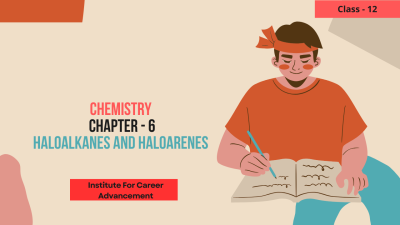
 Compare
Compare
Haloalkanes and haloarenes are organic compounds you'll encounter in Class 12 Chemistry. Here's a quick breakdown of their key features: Halogen Swap: Imagine hydrocarbon molecules (alkanes and arenes) where some hydrogen atoms are replaced by halogen atoms (fluorine, chlorine, bromine, or iodine). These halogen substitutions give rise to haloalkanes and haloarenes. Alkane Twist (Haloalkanes): When a halogen replaces hydrogen in a straight-chain or branched alkane (like methane or butane), you get a haloalkane. Aromatic Addition (Haloarenes): If the halogen attaches to a ring-shaped hydrocarbon molecule (arene) like benzene, you have a haloarene. হ্যালোঅ্যালকেন এবং হ্যালোঅ্যারিন হল জৈব যৌগ যা আপনি দ্বাদশ শ্রেণীতে রসায়নে দেখতে পাবেন। এখানে তাদের মূল বৈশিষ্ট্যগুলির একটি দ্রুত ভাঙ্গন রয়েছেঃ হ্যালোজেন অদলবদলঃ হাইড্রোকার্বন অণু (অ্যালকেন এবং অ্যারেন) কল্পনা করুন যেখানে কিছু হাইড্রোজেন পরমাণু হ্যালোজেন পরমাণু দ্বারা প্রতিস্থাপিত হয়। (fluorine, chlorine, bromine, or iodine). এই হ্যালোজেন প্রতিস্থাপনের ফলে হ্যালোঅ্যালকেন এবং হ্যালোঅ্যারেনের জন্ম হয়। অ্যালকেন টুইস্ট (হ্যালোঅ্যালকেন) যখন একটি হ্যালোজেন একটি সরল শৃঙ্খল বা শাখাযুক্ত অ্যালকেনে (যেমন মিথেন বা বিউটেন) হাইড্রোজেনকে প্রতিস্থাপন করে তখন আপনি একটি হ্যালোঅ্যালকেন পাবেন। সুগন্ধি সংযোজন (হ্যালোঅ্যারেনেস) যদি হ্যালোজেনটি বেনজিনের মতো একটি রিং-আকৃতির হাইড্রোকার্বন অণুর (অ্যারেন) সাথে সংযুক্ত হয়, তাহলে আপনার একটি হ্যালোঅ্যারেইন আছে।
0 Lessons
Hours
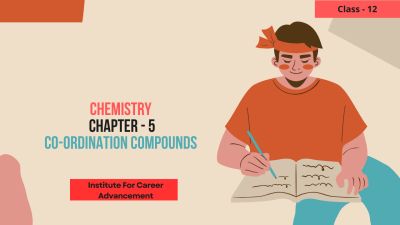
 Compare
Compare
Coordination compounds, covered in Class 12 Chemistry, are a special type of molecule with a central twist! Here's a quick breakdown: Central Attraction: Imagine a metal atom at the center, like a king in his court. A League of Their Own: Surrounding the metal are neutral molecules or ions called ligands. These ligands aren't just bystanders, they form coordinate bonds with the metal using lone pairs of electrons (think of them as gifts offered to the king). A United Front: The central metal and its bonded ligands come together as a complex ion, a tightly knit group within the molecule. Beyond the Basics: Coordination compounds can be positively or negatively charged, or even neutral, depending on the charges of the metal and ligands. দ্বাদশ শ্রেণীর রসায়নে অন্তর্ভুক্ত সমন্বয় যৌগগুলি একটি কেন্দ্রীয় মোড় সহ একটি বিশেষ ধরনের অণু! এখানে একটি দ্রুত ভাঙ্গনঃ কেন্দ্রীয় আকর্ষণঃ কেন্দ্রে একটি ধাতব পরমাণু কল্পনা করুন, যেমন তার দরবারে একজন রাজা। তাদের নিজস্ব একটি লীগঃ ধাতুটির চারপাশে রয়েছে নিরপেক্ষ অণু বা আয়ন যাকে লিগ্যান্ড বলা হয়। এই লিগ্যান্ডগুলি কেবল দর্শক নয়, তারা একক জোড়া ইলেকট্রন ব্যবহার করে ধাতুর সাথে সমন্বয় বন্ধন তৈরি করে। (think of them as gifts offered to the king). একটি ইউনাইটেড ফ্রন্টঃ কেন্দ্রীয় ধাতু এবং এর বন্ধনযুক্ত লিগ্যান্ডগুলি একটি জটিল আয়ন হিসাবে একত্রিত হয়, যা অণুর মধ্যে একটি শক্তভাবে বোনা গ্রুপ। মৌলিক বিষয়ের বাইরেঃ ধাতু এবং লিগ্যান্ডগুলির আধানের উপর নির্ভর করে সমন্বয় যৌগগুলি ধনাত্মক বা ঋণাত্মক আধানযুক্ত হতে পারে, এমনকি নিরপেক্ষও হতে পারে।
0 Lessons
Hours

 Compare
Compare
The d-block and f-block elements in chemistry (covered in Class 12) are fascinating groups of metals with unique properties. Here's a quick breakdown: d-Block (Transition Metals): These elements fill their d-orbitals with electrons in the inner shells. Think of them as the "middle children" of the periodic table, occupying Groups 3 to 12. They're known for their: Shiny metallic appearance Ability to form colored compounds Good conductors of heat and electricity Variable oxidation states (losing or gaining electrons) f-Block (Inner Transition Metals): These elements fill their f-orbitals, located even deeper within the atom. They are positioned at the bottom of the periodic table, separated into two series: Lanthanides (f-orbitals filling) Actinides (5f-orbitals filling) They share some properties with d-block metals but are generally: Less common in nature Radioactive (especially actinides) Have unique magnetic properties রসায়নের ডি-ব্লক এবং এফ-ব্লক উপাদানগুলি (দ্বাদশ শ্রেণীতে অন্তর্ভুক্ত) অনন্য বৈশিষ্ট্যযুক্ত ধাতুর আকর্ষণীয় গোষ্ঠী। এখানে একটি দ্রুত ভাঙ্গনঃ ডি-ব্লক (ট্রানজিশন মেটাল) এই উপাদানগুলি তাদের ডি-অরবিটালগুলি অভ্যন্তরীণ কোষে ইলেকট্রন দিয়ে পূর্ণ করে। তাদের পর্যায় সারণির "মধ্যবর্তী শিশু" হিসাবে ভাবুন, যারা 3 থেকে 12 গ্রুপে রয়েছে। তারা তাদের জন্য পরিচিতঃ চকচকে ধাতব চেহারা রঙিন যৌগ গঠন করার ক্ষমতা তাপ এবং বিদ্যুতের ভাল কন্ডাক্টর পরিবর্তনশীল জারণ অবস্থা (ইলেকট্রন হারানো বা অর্জন) f-ব্লক (অভ্যন্তরীণ রূপান্তর ধাতু) এই উপাদানগুলি তাদের এফ-অরবিটালগুলি পূরণ করে, যা পরমাণুর আরও গভীরে অবস্থিত। এগুলি পর্যায় সারণির নীচে অবস্থিত, দুটি সিরিজে বিভক্তঃ ল্যানথানাইডস (f-orbitals filling) অ্যাক্টিনাইডস (5f-orbitals filling) এগুলি ডি-ব্লক ধাতুগুলির সাথে কিছু বৈশিষ্ট্য ভাগ করে নেয় তবে সাধারণতঃ প্রকৃতিতে কম প্রচলিত তেজস্ক্রিয় (especially actinides) অনন্য চৌম্বকীয় বৈশিষ্ট্য রয়েছে
0 Lessons
Hours

 Compare
Compare
In Class 12 Chemistry, Chemical Kinetics throws you into the exciting world of reaction rates! Get ready to explore: Speed Demons vs. Slowpokes: Delve into the factors that influence how fast a chemical reaction proceeds – concentration, temperature, catalysts, and more. Learn why some reactions happen in a flash, while others take their sweet time. The Art of Measurement: Explore how chemists measure reaction rates – following the change in concentration of reactants or products over time. Reaction Mechanisms: Uncover the hidden steps behind a chemical reaction – like a recipe for the reaction! Understanding the mechanism helps explain the rate and predict the outcome. Rates & Order: Chemical kinetics introduces the concept of reaction rate order – how the concentration of each reactant affects the overall reaction rate. দ্বাদশ শ্রেণীর রসায়নে, কেমিক্যাল কাইনেটিক্স আপনাকে প্রতিক্রিয়া হারের রোমাঞ্চকর জগতে ফেলে দেয়! অন্বেষণের জন্য প্রস্তুত হোনঃ স্পিড ডেমনস বনাম স্লোপোকসঃ একটি রাসায়নিক বিক্রিয়া কত দ্রুত অগ্রসর হয় তা প্রভাবিত করে এমন কারণগুলি অনুসন্ধান করুন-ঘনত্ব, তাপমাত্রা, অনুঘটক এবং আরও অনেক কিছু। জেনে নিন কেন কিছু প্রতিক্রিয়া হঠাৎ করে ঘটে, অন্যরা তাদের মিষ্টি সময় নেয়। পরিমাপের শিল্পঃ সময়ের সাথে সাথে প্রতিক্রিয়াশীল বা পণ্যগুলির ঘনত্বের পরিবর্তন অনুসরণ করে রসায়নবিদরা কীভাবে প্রতিক্রিয়া হার পরিমাপ করেন তা অন্বেষণ করুন। প্রতিক্রিয়া প্রক্রিয়াঃ রাসায়নিক বিক্রিয়ার পিছনে লুকানো ধাপগুলি আবিষ্কার করুন-যেমন বিক্রিয়ার জন্য একটি রেসিপি! প্রক্রিয়াটি বোঝা হারটি ব্যাখ্যা করতে এবং ফলাফলের পূর্বাভাস দিতে সহায়তা করে। হার ও ক্রমঃ রাসায়নিক গতিবিদ্যা প্রতিক্রিয়া হারের ক্রমের ধারণাটি প্রবর্তন করে-কীভাবে প্রতিটি প্রতিক্রিয়াশীলের ঘনত্ব সামগ্রিক প্রতিক্রিয়া হারকে প্রভাবিত করে।
0 Lessons
Hours
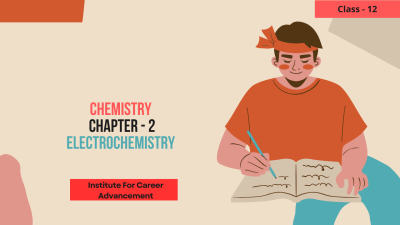
 Compare
Compare
In Class 12 Chemistry, Electrochemistry sparks your curiosity about the fascinating connection between electricity and chemical reactions! This course delves into: Harnessing Chemical Energy: Explore how spontaneous chemical reactions can generate electricity in a device called a galvanic cell (e.g., batteries). Using Electricity for Change: Learn how electrical energy can be used to drive non-spontaneous chemical reactions in a process called electrolysis (e.g., electroplating). Cells & Electrodes: Get to know the key players – galvanic cells and electrolytic cells. You'll understand the role of electrodes (anode and cathode) in these processes. Electrode Potentials & Standard Potentials: Dive into the concept of electrode potential, which measures the tendency of an electrode to lose electrons (oxidation) or gain electrons (reduction). You'll also explore standard electrode potentials, a reference point for predicting the spontaneity of redox reactions in a cell. দ্বাদশ শ্রেণীর রসায়নে, তড়িৎ রসায়ন বিদ্যুৎ এবং রাসায়নিক বিক্রিয়ার মধ্যে আকর্ষণীয় সংযোগ সম্পর্কে আপনার কৌতূহল জাগিয়ে তোলে! এই কোর্সটি নিম্নরূপঃ রাসায়নিক শক্তি ব্যবহারঃ কীভাবে স্বতঃস্ফূর্ত রাসায়নিক বিক্রিয়া গ্যালভানিক কোষ নামে একটি যন্ত্রে বিদ্যুৎ উৎপাদন করতে পারে তা অন্বেষণ করুন। (e.g., batteries). পরিবর্তনের জন্য বিদ্যুতের ব্যবহারঃ জেনে নিন কিভাবে তড়িৎ বিশ্লেষণ নামক একটি প্রক্রিয়ায় অ-স্বতঃস্ফূর্ত রাসায়নিক বিক্রিয়া চালানোর জন্য বৈদ্যুতিক শক্তি ব্যবহার করা যেতে পারে। (e.g., electroplating). কোষ ও বিদ্যুদ্বাহকঃ গ্যালভানিক কোষ এবং তড়িৎবিশ্লেষ্য কোষ সম্পর্কে জানুন। আপনি এই প্রক্রিয়াগুলিতে বিদ্যুদ্বাহকের (অ্যানোড এবং ক্যাথোড) ভূমিকা বুঝতে পারবেন। ইলেক্ট্রোড সম্ভাব্যতা এবং মানক সম্ভাব্যতাঃ বিদ্যুদ্বাহক সম্ভাবনার ধারণায় ডুব দিন, যা একটি বিদ্যুদ্বাহকের ইলেকট্রন হারানোর (জারণ) বা ইলেকট্রন অর্জনের প্রবণতা পরিমাপ করে। (reduction). আপনি স্ট্যান্ডার্ড ইলেক্ট্রোড সম্ভাব্যতাও অন্বেষণ করবেন, একটি কোষে রেডক্স প্রতিক্রিয়াগুলির স্বতঃস্ফূর্ততার পূর্বাভাস দেওয়ার জন্য একটি রেফারেন্স পয়েন্ট।
0 Lessons
Hours